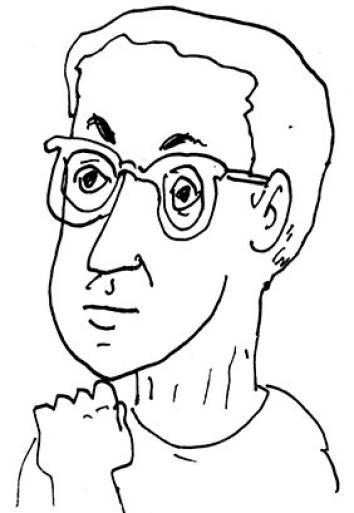I’m a cancer survivor—now 10 years out from mantle cell lymphoma—and I confess to anyone who asks that I mostly handled it badly. During my treatment I was often cranky and depressed. For years I’ve rationalized this by saying that no one handles it well—that the non-cancer world imposes a noble stoicism on cancer patients that is unmerited. When visitors leave and the lights go out for the night, we’re all basket cases. I still use this line to welcome the newly diagnosed. Learning that no one else is rising to the occasion any better than they are helps cheer them up for a second or two.
Except that it’s not strictly true. Some people do figure out how to process their suffering. My college friend, Matt Freedman, a Queens, New York, artist, sculptor, and curator, has done so in an especially inventive and moving way. Remember Maus: A Survivor’s Tale, Art Spiegelman’s famous 1991 graphic novel about the Holocaust? Matt has hand-written a graphic journal of his cancer treatment, a trial by fire that more than 1 in 5 of us will eventually experience. It’s an Everymaus for your future or that of someone close.
The title, Relatively Indolent but Relentless, refers to the way Matt’s doctors describe his adenoid cystic carcinoma, a rare cancer that had spread from his tongue to his neck and lungs by the time he was diagnosed in 2012. But it also describes Matt’s own creative process, and that of millions of others, including me. He lolls around and procrastinates before kicking into high gear.
The relentless creativity of this book was not the product of waiting for the muse to strike. After he got sick, his graduate students in the fine arts and visual studies program at Penn gave him a Moleskine notebook with 240 pages. Matt, who started as a cartoonist, decided he would religiously fill four pages a day for 60 days with thoughts and crude sketches for all seven weeks of painful radiation treatment at Massachusetts General Hospital. (Plus a few more days at either end). “Even if I had nothing worthwhile to say on my own, I figured I would at least have a relatively unvarnished and reliable record of what was sure to be an interesting experience,” he writes in the preface.
Besides clarifying some of the hand-lettered writing (many of his T’s looked like U’s), neither Matt nor his publisher changed a single word before publication. Fortunately, he rebuffed efforts by Seven Stories Press to make him set his jottings in print text. This allows for the rawness to come through. The book is by turns poignant, funny, harrowing, confused, amused, annoyed, distracted, inspired, and even occasionally indolent—an indelible illustration of what those of us marooned on cancer island have lived (or not lived) through.
Matt is much more comfortable making art than talking about it, but he tried to bring me into his creative process. “The idea of trying to invent something you didn’t expect is crucial for me,” he says, quoting an avant-garde composer who said: “If I can [fully] imagine something, then I’m not interested in making it because all I’ll be doing is illustrating an idea I had. I need to create a system that forces me to extend myself beyond my imagination.” The composer tightens the formal strictures of his composition (allowing, say, only certain notes), in the same way a poet will uses the strictures of a sonnet or iambic pentameter to enhance his creativity. For Matt, the form was: fill four pages a day, every day, with something. Even when he failed to come up with his best work, the process surprised and thus satisfied him for long enough to help him through another rough day, until the process began again. “I wish I had the mental discipline that could compartmentalize the possibility of dying and concentrate on the awareness and experience of living,” he says. “But for me they’re interwoven, which makes living more interesting.”
While his artistic background gave him “an oasis,” Matt wants to make his intentions clear: “I wasn’t trying to make art, because that’s too abstract an idea. I wanted to see how good I could make something and how truly I could speak about something.”
Matt grew up in Chicago, the son of a well-known professor of psychiatry at the University of Chicago with a specialty in treating serial killers. He remembers the family receiving a Christmas card sent from jail by John Wayne Gacy, soon to be executed for sexually assaulting and murdering at least 33 boys in the 1970s and burying them in the basement of his suburban home. The card seemed normal enough: “To Dr. Freedman, with gratitude and affection, wishing you and yours a joyous holiday season.” But on the back Gacy slipped in a typed note on heavy crème paper that added: “Hey, doc, how’s it hangin’?”
It’s hardly surprising that Matt has thought about evil a lot over the years and he rejects the normal Manichean mindset that characterizes discussion of cancer. He knows his odds aren’t good (his doctors tell him that 15 percent of those with his condition are alive after five years) but he refuses to go into battle mode as he awaits advances in treatment that may save his life. “The sense that cancer is the bad guy and I’m the good guy is a huge weight on the patient,” he says.
A better approach, though not for everyone, is to “scrape the bottom of one’s creativity.” Even if you are unable to make art, Matt says, you should try to make something, anything, to get the creative juices flowing. If you don’t merely fall back on your old habits to get you through, you’re ahead of the deadly game. “I wouldn’t say, as some people do, that life is sweeter now because I savor it more,” he concludes. “I just feel kinda alert.”
